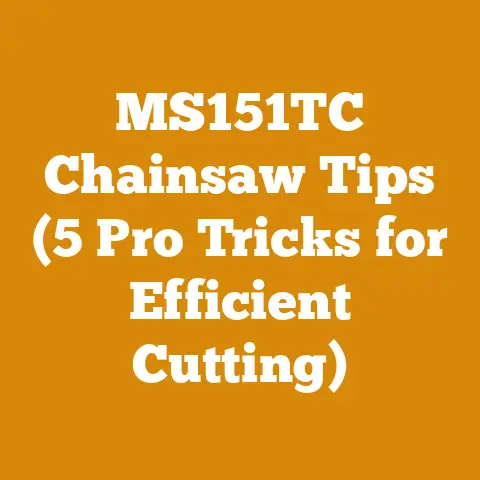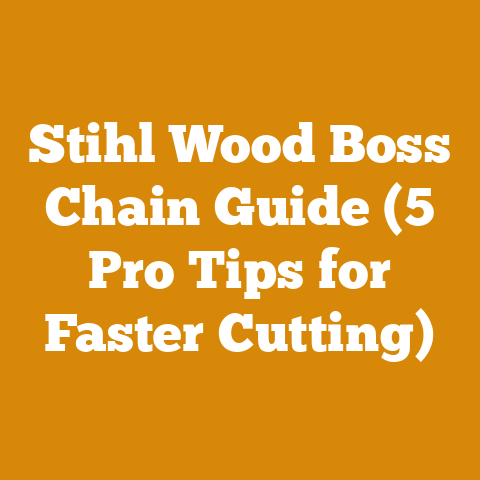How Much Is a Bundle of Firewood? (5 Pro Tips for Buyers)
I’ve spent a good chunk of my life around wood – from felling trees in the crisp autumn air to splitting logs under the summer sun, and finally stacking firewood for the long winter months. I can still remember the sting of a poorly aimed swing of the axe, the satisfying crack of a perfectly split log, and the smoky scent of seasoned wood burning in the hearth. Over the years, I’ve learned a thing or two about firewood, including how to get the best bang for your buck. One of the most common questions I get asked is, “How much is a bundle of firewood, really?” It seems simple, but there’s more to it than meets the eye. Let’s dive in and explore the world of firewood bundles, and I’ll share my top 5 tips for buyers.
How Much Is a Bundle of Firewood? (5 Pro Tips for Buyers)
Determining the true cost of a bundle of firewood isn’t just about the price tag. It’s about understanding volume, wood type, moisture content, and ultimately, how much heat you’ll get for your money. In this guide, I’ll break down the complexities of firewood pricing and share practical tips to help you make informed decisions.
Understanding Firewood Measurements: What’s a Bundle, Anyway?
The first step in figuring out if you’re getting a good deal is understanding the different ways firewood is measured. It can be a bit confusing, but I’ll break it down.
A “bundle” of firewood is typically a small, pre-packaged amount of wood, often sold at gas stations, grocery stores, and campgrounds. It’s the go-to for a single evening fire or a weekend camping trip. The problem is, there’s no standard size for a bundle.
- Common Bundle Sizes: Most bundles range from 0.5 to 1 cubic feet. I’ve seen some advertised as “generous” bundles that might push closer to 1.25 cubic feet, but those are rare.
- The Cord: A cord is the standard unit for measuring firewood. A full cord measures 4 feet high, 4 feet wide, and 8 feet long, totaling 128 cubic feet.
- The Face Cord (or Rick): This is where things get tricky. A face cord (sometimes called a rick or a stove cord) is 4 feet high and 8 feet long, but its depth varies. This makes it difficult to compare prices without knowing the log length. A common log length is 16 inches, which would make a face cord 1/3 of a full cord.
Why This Matters: Knowing these measurements helps you compare prices. If a bundle costs $10 and contains 0.75 cubic feet, you can calculate the price per cubic foot. Then, compare that to the price of a face cord or full cord from a local supplier.
Takeaway: Don’t be fooled by vague terms. Always ask about the cubic footage of a bundle to make an informed price comparison.
Pro Tip #1: Calculate the Price Per Cubic Foot
This is my go-to method for comparing firewood prices, regardless of how it’s being sold. Here’s how you do it:
- Determine the Volume: Find out the cubic footage of the bundle. If it’s not listed, ask the seller.
- Divide the Price by the Volume: Divide the price of the bundle by its cubic footage. For example, if a bundle costs $8 and contains 0.5 cubic feet, the price per cubic foot is $16 ($8 / 0.5 = $16).
- Compare to Larger Quantities: Get quotes for a face cord or full cord from local firewood suppliers. Divide the price of the larger quantity by its cubic footage (remember, a full cord is 128 cubic feet) to get the price per cubic foot.
- Make the Comparison: Now you can directly compare the price per cubic foot of the bundle to the price per cubic foot of the larger quantity.
Example:
- Bundle: $10 for 0.75 cubic feet = $13.33 per cubic foot
- Face Cord (1/3 cord): $150 for 42.67 cubic feet = $3.51 per cubic foot
In this example, the bundle is significantly more expensive per cubic foot than the face cord.
Why This Works: This method standardizes the pricing, allowing you to see the true cost of the wood, regardless of how it’s packaged.
Takeaway: Calculating the price per cubic foot is essential for smart firewood buying. It helps you avoid overpaying for the convenience of a small bundle.
Pro Tip #2: Identify the Wood Species
Not all firewood is created equal. Different wood species have different densities, which affects how much heat they produce and how long they burn.
- Hardwoods vs. Softwoods: Hardwoods, like oak, maple, ash, and beech, are denser than softwoods like pine, fir, and spruce. Denser wood contains more energy and burns longer, providing more heat.
- BTU (British Thermal Unit) Ratings: BTU is a measure of heat energy. Firewood BTU ratings indicate how much heat a specific wood species produces per cord.
-
Common Firewood Species and Their BTU Ratings (per cord, approximate):
- Oak: 27 million BTU
- Maple: 24 million BTU
- Ash: 24 million BTU
- Beech: 24 million BTU
- Birch: 20 million BTU
- Pine: 16 million BTU
- Why This Matters: A bundle of oak will provide more heat and last longer than a bundle of pine, even if they’re the same size.
My Experience: I once made the mistake of buying a “cheap” bundle of firewood from a roadside stand. It turned out to be mostly pine. It burned quickly, produced a lot of smoke, and didn’t provide much heat. I learned my lesson – always ask about the wood species!
Takeaway: Knowing the wood species is crucial. Hardwoods are generally a better value than softwoods, even if they cost a bit more upfront.
Pro Tip #3: Check the Moisture Content
The moisture content of firewood is a critical factor in its burning efficiency. Green (freshly cut) wood contains a lot of water, which reduces its heat output and creates more smoke.
- Seasoned vs. Green Wood: Seasoned wood has been dried for at least six months to a year, reducing its moisture content. Green wood is freshly cut and has a high moisture content.
- Ideal Moisture Content: The ideal moisture content for firewood is between 15% and 20%.
-
How to Check Moisture Content:
- Moisture Meter: A moisture meter is the most accurate way to check the moisture content of firewood. These are relatively inexpensive and easy to use.
- Visual Inspection: Look for cracks in the ends of the logs. Seasoned wood will typically have splits and checks.
- Weight: Seasoned wood will be noticeably lighter than green wood.
- Sound: When you strike two seasoned pieces of wood together, they will make a hollow sound. Green wood will sound dull.
- Why This Matters: Burning green wood is inefficient and can damage your chimney due to creosote buildup, which is a fire hazard.
My Insight: I use a moisture meter religiously. It takes the guesswork out of determining if my firewood is ready to burn. I aim for a reading below 20% before I consider the wood seasoned.
Takeaway: Always check the moisture content of firewood before you buy it. Seasoned wood is essential for efficient and safe burning.
Pro Tip #4: Inspect for Bugs and Rot
Before you bring firewood home, take a close look for signs of insects or rot. You don’t want to introduce pests into your home or yard.
- Signs of Insects: Look for small holes in the wood, sawdust-like material (frass), or live insects.
- Signs of Rot: Look for soft, spongy wood, discoloration, or a musty smell.
- Why This Matters: Infested firewood can introduce invasive species like the emerald ash borer or Asian longhorned beetle, which can devastate local trees. Rotting wood is less efficient to burn and can be a health hazard.
-
Best Practices:
- Buy firewood locally to minimize the risk of transporting invasive species.
- Store firewood away from your house to prevent insects from entering your home.
- Only bring in as much firewood as you need for a few days.
Real-World Example: A friend of mine unknowingly brought home firewood infested with termites. It took months and a lot of money to eradicate them from his house. It’s a costly mistake to avoid.
Takeaway: Inspect firewood carefully for signs of insects and rot before you buy it. Protecting your home and local ecosystem is worth the effort.
Pro Tip #5: Consider Alternatives to Bundles
While bundles are convenient, they’re often the most expensive way to buy firewood. Consider these alternatives for better value:
- Buying in Bulk (Face Cord or Full Cord): Buying firewood in larger quantities is almost always cheaper per cubic foot. If you have the space to store it and burn firewood regularly, this is the way to go.
- Local Firewood Suppliers: Look for local firewood suppliers in your area. They often offer better prices and higher-quality wood than gas stations or grocery stores.
- Cutting Your Own Firewood: If you have access to land and the necessary equipment (chainsaw, axe, log splitter), cutting your own firewood can be the most economical option.
- Cooperative Buying: Team up with neighbors or friends to buy a large quantity of firewood and split the cost and the wood.
- Kiln-Dried Firewood: Kiln-dried firewood has been artificially dried in a kiln to a very low moisture content (typically below 10%). It burns very efficiently and produces minimal smoke, but it’s usually more expensive than seasoned firewood.
Case Study: I once compared the cost of buying bundles of firewood for an entire winter to buying a face cord. The face cord was significantly cheaper, even after factoring in the cost of renting a log splitter to process the wood.
Takeaway: Explore alternatives to bundles for more cost-effective firewood options. Buying in bulk or cutting your own firewood can save you a significant amount of money.
Additional Considerations for Firewood Buyers
Beyond the five pro tips above, here are a few more things to keep in mind when buying firewood:
- Storage: Store firewood in a dry, well-ventilated area, off the ground. This will help it season properly and prevent rot.
- Safety: Always wear safety glasses and gloves when handling firewood. Use caution when splitting logs with an axe or log splitter.
- Regulations: Be aware of any local regulations regarding firewood transportation or burning. Some areas have restrictions to prevent the spread of invasive species.
- Environmental Impact: Consider the environmental impact of your firewood choices. Buy from sustainable sources and avoid burning treated wood or construction debris.
- Negotiation: Don’t be afraid to negotiate the price, especially when buying in bulk. Firewood prices can fluctuate depending on the season and demand.
A Quick Word on Chainsaws and Log Splitters
Since I mentioned cutting your own firewood, let’s briefly touch on chainsaws and log splitters. These tools can make the job much easier and more efficient, but they also require proper training and safety precautions.
- Chainsaws: Choose a chainsaw that’s appropriate for the size of the trees you’ll be felling and the type of wood you’ll be cutting. Always wear safety glasses, hearing protection, and chaps when operating a chainsaw. Maintain your chainsaw regularly, including sharpening the chain and checking the oil levels.
- Log Splitters: Log splitters can be hydraulic or manual. Hydraulic log splitters are more powerful and can handle larger logs. Always wear safety glasses and gloves when operating a log splitter. Follow the manufacturer’s instructions carefully.
- Safety First: Never operate a chainsaw or log splitter under the influence of drugs or alcohol. Always be aware of your surroundings and keep bystanders at a safe distance.
Firewood and the Future
As we become more aware of environmental concerns, sustainable firewood practices are becoming increasingly important.
- Sustainable Harvesting: Choose firewood from suppliers who practice sustainable harvesting methods, ensuring the long-term health of the forest.
- Alternative Fuels: Consider alternative fuels like wood pellets or biofuel, which can be more environmentally friendly than traditional firewood.
- Efficient Burning: Use a modern, EPA-certified wood stove or fireplace to maximize heat output and minimize emissions.
Final Thoughts: Making the Right Choice
Buying firewood doesn’t have to be a gamble. By understanding the measurements, wood species, moisture content, and potential problems, you can make informed decisions and get the best value for your money. Remember to prioritize safety and sustainability, and enjoy the warmth and comfort of a crackling fire.
I hope these tips have been helpful. Happy burning!






